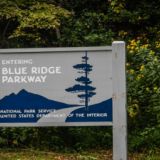The Greenbrier Experience in Great Smoky Mountains National Park
…feeling great in GREENBRIER!
The Greenbrier section of Great Smoky Mountains National Park can be found six miles east of Gatlinburg, Tennessee on Highway 321. Also known as Big Greenbrier, this watershed is widely considered the finest example of a cove hardwood forest on planet Earth. The entrance to the cove is a narrow paved road which meanders alongside the Middle Prong of the Little Pigeon River.
A Driving Tour of Greenbrier
The first mile into Greenbrier has many riverside pull outs for fishing, paddling, and the occasional wedding ceremony. After passing the ranger station the road turns to gravel and narrows, so please be courteous and allow room for other vehicles to maneuver. Past the ranger station the next landmark will be a quiet picnic area on the left next to the river. The picnic grounds have several tables and composting toilets.
Traveling on you will soon find a pair of bridges on the left. The Grapeyard Ridge trail begins on the west side of the bridges. Grapeyard Ridge meanders 7.6 miles west ending at the Cherokee Orchard Motor Nature Trail.
The Old Settler’s trail begins on the east side of the bridges. Old Settlers trail stretches 15.9 miles east to its junction with Maddron Bald trail and Gabes Mountain trail.
Turn left onto the bridge and drive 1.5 miles to the Ramsay Cascade trailhead. Ramsay Cascades is a tough eight mile round trip hike to one of the tallest and most beautiful waterfalls found in the Great Smoky Mountain National Park. The trail is renowned for its old growth forest and giant trees in addition to the awe inspiring waterfall.
Remaining straight at the bridge will bring you to the second picnic area found in Greenbrier. This spot has a covered pavilion, picnic tables, a pure, running spring and composting toilets.
A half mile after the picnic area the road dead ends at the Porters Creek trailhead. Porters Creek trail is 3.7 miles long and is a favorite among wildflower enthusiasts during the spring. Porters Creek trail also provides access to the historic Smoky Mountain Hiking Club cabin and the Brushy Mountain Trail. Brushy Mountain is 4.7 miles long to its junction with Trillium Gap trail and is considered one of the most challenging ways to access the summit of Mt. Leconte.
“My family first discovered Greenbrier a few years ago. We followed some kayakers up the river and watched them shoot the rapids while we had a picnic and skipped stones. I’m not sure, but I think we had more fun than they did. No doubt there are numerous ways to enjoy this beautiful piece of paradise,” says Hank from Cumming, Georgia.
Take some time and discover Greenbrier for yourself and see what makes this ecological marvel so special. With over one hundred species of trees concentrated in this land, more than twice as many as the continent of Europe, it is easy to appreciate all the variety. Don’t miss the fall color display. The sight has been likened to a rainbow blanketing the mountain sides.
History of Greenbrier
Big Greenbrier was settled by the Whaley family in 1810 and grew to a population of over one thousand residents at its zenith. During those bygone days there were eight distinct communities in the cove. These folks lived off the land and were self-sufficient. Most folks never had store bought goods except occasionally coffee and sugar. The most important crop in the watershed was corn. All vegetables were produced in gardens alongside apple orchards, grape vineyards, peach and plum trees. Corn production was so prolific that there were twenty two grist mills located on the streams and tributaries in the cove. Looking out into this pristine forests it is hard to imagine there were once three churches, four schools, three blacksmith shops and a twenty room hotel located here.












